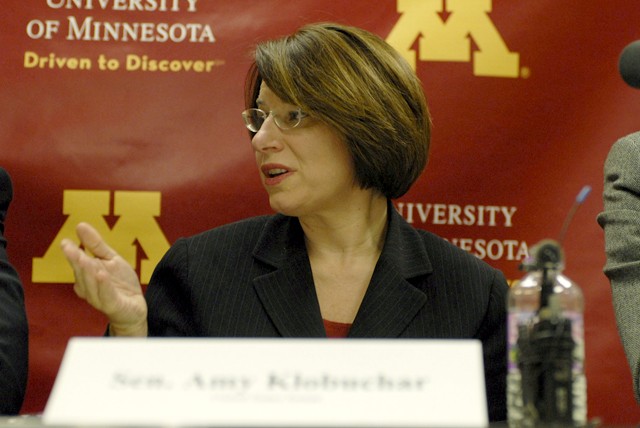Michael Osterholm , director of the Center for Infectious Disease Research and Policy, has a daughter who is eight months pregnant and works in immunology. Knowing that his daughter works with patients infected with H1N1, Osterholm so anticipated a particular phone call that he knows exactly what time it came in. âÄúI canâÄôt tell you, the moment she got her vaccine, the relief I got,âÄù Osterholm said. âÄúShe called me at 6:27 in the morning.âÄù Osterholm told the story Friday morning during a panel discussion with Sen. Amy Klobuchar, D-Minn., Hamline University law professor Lucinda Jesson and Rob Fulton , director of the St. PaulâÄìRamsey County Department of Public Health. The discussion came one day after the Center for Disease Control and Prevention released new numbers on H1N1, commonly referred to as âÄúswine flu.âÄù The CDC reported that more than 4,000 Americans have died from H1N1, and 22 million have been infected since April. H1N1 is blamed for 21 deaths in Minnesota during the same time period. The original estimates from the PresidentâÄôs Council of Advisers on Science and Technology had estimated at least 30,000, and as many as 90,000 deaths from H1N1. This week, the CDC will release a revised estimate, which will put the number of flu deaths closer to the average yearly total of 36,000. Klobuchar said the number of Minnesotans hospitalized for the flu has declined in the past two weeks, but said that the shortage in flu vaccines and the unpredictable nature of pandemics leaves cause for concern. âÄúThe only thing we know for certain about what will happen next is that we canâÄôt be certain,âÄù Klobuchar said. âÄúWe do know the H1N1 flu has gotten ahead of the public health systemâÄôs ability to respond effectively.âÄù The discussion was held in part to address parentsâÄô frustration at being unable to have their children vaccinated. A recent Associated Press-GfK poll reported that while nearly one in six parents had gotten a vaccine for their child, 14 percent of parents had tried, but were unsuccessful. Klobuchar revealed that she and her own 14-year-old daughter are among those affected by the shortage. âÄúIâÄôve made those calls too, to see where that vaccine can be found,âÄù Klobuchar said. âÄúWe still havenâÄôt found it.âÄù Klobuchar blamed the lack of available vaccines on the 1950s-era method in which they are created. Using the current technique, which grows the virus in millions of chicken eggs, vaccines take at least six months to produce. âÄúThe limitations of the traditional approach to making vaccines have been exposed,âÄù Klobuchar said. Osterholm said that more vaccines may be available in four to six weeks. During the same time period, he expects the number of flu hospitalizations to continue to decrease. But he fears that the flu will reappear again early in 2010. âÄúItâÄôs very possible, based on previous pandemics, that we could very well see a major January-February-March wave,âÄù Osterholm said. Osterholm expressed concern that the public awareness of H1N1 will wane as the rate of incidence declines, meaning the 2010 wave could catch many unvaccinated people by surprise. The 1918 âÄúSpanish fluâÄù pandemic killed 675,000 Americans and at least 35 million people worldwide. That flu came in three waves over a period nearly a year, and the second wave was more deadly. If there was one fortunate aspect to the H1N1 strain of flu, Osterholm said, it was that it has so far exhibited âÄúvery, very limitedâÄù mutations. Fulton gave a briefing earlier this month to the U.S. House of Representatives Labor, Health and Human Services, and Education Subcommittee. On Friday, when Klobuchar asked him what the federal government could do to help him on the local level, Fulton rubbed his fingers together in the well-known gesture meaning âÄúmoney.âÄù He went on to say that the government needs greater efficiency in distributing information and managing expectations, before returning to his initial point. âÄúOf course, Senator, you can always send more money,âÄù Fulton said. Klobuchar wants to do just that. After the discussion, Klobuchar said that even if the U.S. weathers the swine flu, she will advocate for more research money. Klobuchar called for newer domestic technologies to develop vaccines, citing that 80 percent U.S. vaccines are produced overseas, âÄúI think we all have realized how scary this situation is, that weâÄôre so dependent on foreign countries,âÄù Klobuchar said. âÄúI think [the slow reaction this year] shows that we need stockpiles, that weâÄôre just not relying on what happens each year, that we plan ahead each year.âÄù When the panel opened the floor for questions, one audience member asked about public fear of the flu vaccine. Osterholm cited a recent poll in which nearly half of those surveyed said they were afraid of the vaccine, and did not mince words in his criticism of those who are causing the fear. âÄúThe anti-science movement of the world is unfortunately real,âÄù Osterholm said. âÄúIâÄôm going to be real honest: theyâÄôre quacks that are on the internet making up charges that are simply not true, and are believed by many.âÄù

















